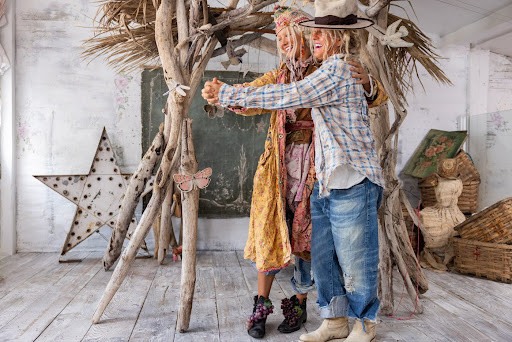Magnolia Pearl's Secret To Success? Slowing Down, Giving Back And Staying Real

It began with a kite string. Not the metaphorical kind that business leaders love to invoke in speeches about humble beginnings, but literal kite string, threaded through a tattered tapestry by a woman sitting at her kitchen table in Texas, hoping to stitch together enough hope to keep going. Robin Brown didn't set out to build an international clothing brand. She was trying to make a bag. She needed the money, and a stranger in a parking lot offered to buy it - the exact amount she needed at that moment.
That first bag became a pivot point, the beginning of what would become Magnolia Pearl: a brand defined by garments that look as though they've lived long, imperfect lives. Today, Magnolia Pearl has two flagship stores - one in Fredericksburg, Texas, and another in Malibu, California - and its clothes appear in more than 400 boutiques worldwide. But its origin story, much like the hand-distressed hems and patchwork seams of its garments, is rough-edged, unfinished, and entirely deliberate.
Designing for Imperfection
Magnolia Pearl's clothes don't aim for sleek perfection. They are built to look worn from the moment they reach the rack. Raw edges, visible mending, faded colors - these are not accidents but the point. Brown's designs reflect a worldview forged in hardship. She grew up poor, frequently homeless, her childhood marked by abuse. Clothing, for her, was survival.
Magnolia Pearl's design has struck a nerve at a time when many consumers are reconsidering their relationship to fashion. Fast fashion fills closets with cheap, disposable garments, but more people, especially younger shoppers, are seeking clothes with longevity and meaning. The global apparel resale market, valued at $227 billion in 2024, is projected to keep growing at double-digit rates through 2030. And Magnolia Pearl's garments, with their intentionally imperfect craftsmanship, feel tailor-made for this moment.
The Resale Market as Community
Before the brand formalized it, Magnolia Pearl garments had already become prized objects in an informal resale market. Collectors traded the brand's rare, small-batch pieces on consignment sites and social media, often at prices that far exceeded their original retail value.
In 2023, the company responded by launching Magnolia Pearl Trade, an online platform that lets collectors list authenticated garments and bid on rare finds. But this wasn't just about capturing resale value. The platform routes a portion of every transaction, between 25% and 100%, to charity via the Magnolia Pearl Peace Warrior Foundation, the nonprofit arm Brown and Gray established in 2020.
In some ways, Magnolia Pearl Trade is as much about storytelling as commerce. The garments themselves tell stories through their distressing and patching; the resale platform extends that narrative, embedding new lives for each piece in a community of collectors who value them not just as products but as artifacts.
Philanthropy Woven Into Every Stitch
Charitable giving is not an afterthought at Magnolia Pearl; it is a central part of the brand's business model. Since 2020, the Magnolia Pearl Peace Warrior Foundation has donated over $550,000 to organizations that serve Indigenous American veterans, provide disaster relief, and offer healthcare and housing to the homeless.
Charitable giving is not an afterthought at Magnolia Pearl; it is a central part of the brand's business model. Since 2020, the Magnolia Pearl Peace Warrior Foundation has donated over $550,000 to organizations that serve Indigenous American veterans, provide disaster relief, and offer healthcare and housing to the homeless.
This commitment reflects how Brown's personal history has influenced the company's values. Her own experience with scarcity has shaped a philosophy that ties commerce directly to giving. Even production samples that do not make it into a collection are sold or upcycled rather than discarded, ensuring that waste is minimized and value is redirected.
Slowing Down, Staying Small
Magnolia Pearl has grown significantly, but it still does things at a different pace than most fashion brands. Production runs remain limited, and releases happen when the pieces are ready, not according to a rigid seasonal calendar. The company's two flagship stores are designed more like galleries than traditional retail spaces, showcasing garments as objects worthy of reflection rather than just consumption.
This slower strategy seems counterintuitive in an industry built on volume and velocity. But Magnolia Pearl's careful, curated growth aligns with rising consumer skepticism toward mass production and disposable culture. Younger shoppers, in particular, are drawn to brands that feel human and handcrafted, that offer not just goods but values.
A Brand as a Story
Magnolia Pearl is, at its core, a storytelling company. The garments are stories - about Brown's life, about repair and resilience, about embracing imperfection. The resale platform is a story about community. The Peace Warrior Foundation is a story about giving back.
And Brown herself remains a central character in this ongoing narrative. Her memoir, Glitter Saints: The Cosmic Art of Forgiveness, released in 2024, reads as both personal history and a design philosophy, tracing how her childhood experiences shaped the aesthetic that now attracts celebrity fans and collectors around the world.
Magnolia Pearl's secret to success? It's about pacing, purpose, and people. Instead of chasing speed and scale, Magnolia Pearl is betting on something different: slow growth, giving back, and staying real.
© Copyright IBTimes 2025. All rights reserved.



















